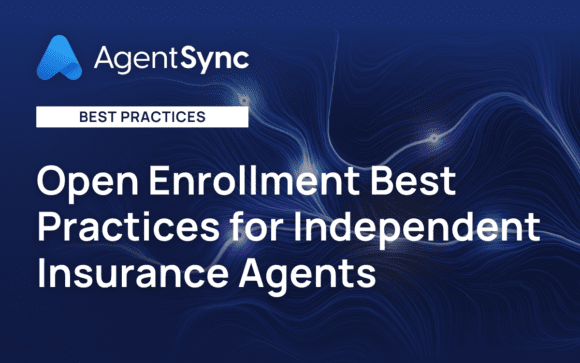Open Enrollment 2023 Best Practices for Independent Insurance Agents

This post is part of a series sponsored by AgentSync.
Open enrollment season for benefits, both employer-sponsored and private, is approaching. Brush up on some best practices to make the season smoother at your independent agency.
For insurance agents who work in benefits, the start of fall means more than pumpkin spice everything. It’s also the start of annual open enrollment periods across the U.S.
While some employee benefits plans renew outside of the traditional period – with strange renewal dates spanning from Feb. 1 to July 1, or beyond – the vast majority of health insurance plans renew on Jan. 1 each year. This is true of most employer-sponsored group benefit plans and those found on state and federal insurance marketplaces. That means, starting around Oct. 1, it’s open enrollment time!
Across the wide world of insurance, benefits are a niche that not all producers are licensed to sell. However, if you’re one of the estimated 138,682 licensed health insurance agents in the U.S., we know your world gets extremely hectic through mid-December. Whether you currently sell benefits, are considering moving into benefits, or support producers who sell benefits, we hope these open enrollment best practices will help you this season.
Also, in honor of open enrollment season and those of you who love benefits as much as we do, we’re kicking off a three-part series covering the history of health insurance benefits (past, present, and future). Stay tuned for the first installment, coming soon.
What is open enrollment?
Open enrollment is an annual opportunity for plan members to make changes to their benefits without any type of special qualifying circumstances. Most commonly, health insurance, dental insurance, vision insurance, life insurance, and disability insurance have annual open enrollment periods. This is especially true for group plans and employer-sponsored plans.
Why is open enrollment important for plan members?
Open enrollment matters to individuals and plan members because it’s their chance to reevaluate their benefits and make changes for the coming year. This can include switching to a different priced health plan, choosing coverage they didn’t have in the past, declining coverage they currently have, or increasing coverage amounts for benefits like life insurance. Outside of open enrollment, these types of changes aren’t allowed without a specific “qualifying life event” like getting married, divorced, changing jobs, or having a baby (among others).
Why do insurance agents and carriers care about open enrollment?
Open enrollment matters to insurance carriers and insurance agents because it’s a time when they have a large amount of earning potential. How so? For one thing, as health insurance costs continue to rise, licensed health insurance producers can increase their commissions through increased sales. On top of that, employers are trying to find new ways to entice and incentivize an increasingly burnt out workforce, and are adding new benefits at open enrollment, which can represent significant earnings potential for carriers and agents alike.
How to prepare for open enrollment
Start early with a benefits review
Whether your client is an individual or a large employer purchasing benefits for its employees, it pays to start looking at options early. For individuals you’re helping purchase health insurance on the health insurance marketplace, it could be as simple as a quick phone call to see how they liked their coverage this year and if they found any gaps they’d like to address by changing plans.
You can ask if they felt their coverage was affordable and help them look for alternatives if it wasn’t. You can even use this opportunity to educate your clients on ways they may be able to save money and run through options they may not have previously considered, like choosing a qualified high-deductible health plan along with opening a health savings account.
For group coverage, you’ll have to spend a bit more time and you’ll probably have to put together proposals and suggestions for different plans across different health insurance carriers to address the group’s utilization and costs. If you have multiple group benefits clients, it becomes even more important to start early to make sure they can select plans in time to properly communicate any changes to group members.
Communicate benefit options and market benefits to plan participants
Benefits are complex and difficult for most people to understand. Since open enrollment is the only time for most people to make choices about, and changes to, their benefits for an entire year, it’s vital that they understand their options.

If you’re working with employer sponsored benefit plans:
It’s very important that plan members (employees and their dependents) understand the value of their benefits as part of the total compensation package.
You can help your group benefit clients educate and communicate with their plan members by providing benefit enrollment guides, collecting collateral from the insurance carriers, and holding live meetings with Q&A opportunities.
It can take multiple times and multiple methods to adequately communicate benefits to employees. Make sure your communication strategy involves mail, email, web, video, audio, written, and in-person options across at least a couple of months’ time so everyone has an opportunity to absorb the information before it’s time to enroll.
If you’re working with individuals purchasing health insurance on the marketplace or through non-marketplace plans:
Depending on the geographic region, some people will have an overwhelming number of choices while others will have very limited choices. Both situations come with their own challenges.
Consumers may not realize they can access your expert help at no cost to them. When purchasing a plan on the marketplace, the price doesn’t increase for the plan member regardless of buying it through a licensed agent.
People may not realize the types of subsidies they qualify for, thus overestimating the cost of a marketplace health plan and avoiding purchasing the coverage they need.
Your role as a benefits broker or agent is that of an advisor and educator as well as salesperson. We know open enrollment time can be lucrative, but remember, the best way to ensure a long-term successful relationship with your individual and group benefits clients is to help them understand what they need and how the benefits you’re selling will actually impact their lives.
Leverage technology to help your clients and their employees during the annual open enrollment period
As the saying goes: Work smarter, not harder. There are plenty of ways to lighten your load during open enrollment season by using technology. It probably won’t surprise you that this is one of our best practices, since we at AgentSync are slightly obsessed with automating manual processes and modernizing the insurance industry. Here are just a few ways being tech-forward in your open enrollment practices can speed things up, reduce errors, and result in a fantastic user experience for your benefits clients and each plan member.
Leverage an online benefits enrollment system
Asking people to complete anything with paper and pen is probably an exercise in futility in 2022. Online benefit enrollment systems guide people through their options, prevent enrollment mistakes, and can even offer built-in education on the benefit offerings. Even better if your clients can implement a system that integrates with their current HR and payroll systems. Depending on what they use (Workday or Rippling, for example), some HR systems include benefits as a core functionality.
Use video and web-conferencing instead of in-person meetings
Helping employees understand their employer’s health plan and other benefit offerings is a noble undertaking. But you don’t have to repeat yourself until you lose your voice all for the sake of education! Studies indicate that nearly half of employees say video is the most engaging form of communication at work. Recording a video presentation and being on-hand to answer questions is a great use of technology that’ll make your open enrollment season less painful.
Whether you do a fully pre-recorded video or a live webinar that’s also recorded for future reference, either option lets you maximize your impact while minimizing your time commitment. Just remember if you go this route, it’s important your message is customized to the group you’re speaking to and not overly generic, or else it loses its value. It’s also important to give people the chance to ask questions, which is why a live Q&A after a recorded video can be the best of both worlds.
Ready, set, enroll!
Equipped with these best practices, we hope you’re ready to dive into open enrollment season. Make sure to check out our upcoming blogs about the history of benefits if you’re looking for some educational reading material in between benefit enrollment sessions.
If you’re interested in best practices not just for open enrollment, but for managing the entire producer licensing process, see how AgentSync can help.
Topics
Agencies





